. . . .
SATURDAY
AUGUST 25 2018 - Kingley Vale
Steph Dale
reported on the walk
12 of us met at the car park on the southern side of
Kingley Vale on a lovely sunny morning. Before we had
even covered the ground between the car park and the
entrance to the Nature Reserve, we had seen a
redstart, wheatear, kestrel, buzzards, chiff chaff,
wren, robins, yellowhammer, green woodpeckers and a
cormorant flew over. On the left near the entrance to
the Reserve over the fields we saw house martins and
swallows and Neil spotted a hobby amongst
them.
Butterflies seen were
speckled woods, small whites, a comma, common blues
and meadow brown. We also saw a common darter.
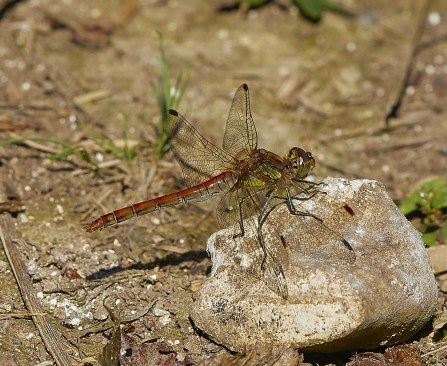
In the reserve, we saw
a good selection of flowers including hemp agrimony,
agrimony, perennial sowthistle, prickly sowthistle,
spear thistle, marsh thistle, hedge mustard, vervain,
nipplewort, small scabious, harebells, white and red
campion, fairy flax, eyebright, knapweed, red bartsia,
wild parsnip, marjoram, wild basil, white deadnettles,
toadflax, travellers' joy, field bindweed, burnet
saxifrage, common mallow, hogweed and pineapple
mayweed. There were many blackberries, haws,
elderberries and sloes.
Further birds seen were a baby bullfinch (our best
identifiers of bird calls were mystified by the calls
of the baby bullfinches until they were able to spot
them), goldfinches, a dunnock, whitethroat, coal tits,
blue tits, great tits. We were delighted to see some
spotted flycatchers in the trees..
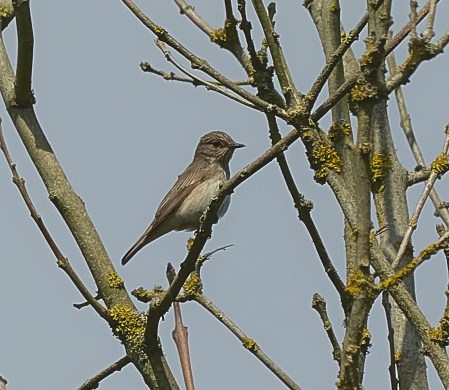
The dew pond at the
far end of our walk was completely devoid of water.
Thank you to Derek and Caroline for the lovely photos.
Also thanks to all for your company and
expertise.
SATURDAY
AUGUST 18 - 2018 - Old Winchester Hill
Heather Mills
reported on this morning's walk by the Havant Wildlife
Group
10 met on a cloudy morning at Old Winchester Hill. We
managed to catch a glimpse of one Yellowhammer and a
Kestrel hovering above the hillside before taking the
usual route to the fort and hearing one Skylark high
above us but not in full song. As we were alerted to 2
Ravens cawing as they flew below us over the field
looking towards the Isle of Wight, we noted a flock of
Herdwick sheep.
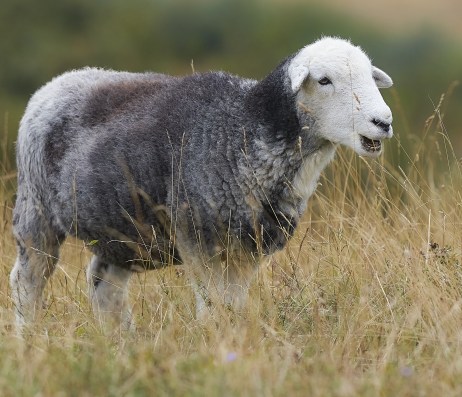
The Common and
Chalk-hill blues began to emerge along with Meadow
Browns, Small Copper and Small Heath. I had hoped to
be able to share in the sighting of the Silver
spotted Skipper and we all had the good fortune to
be able to see 3 because it was a cool morning and
they were not yet on the wing.
All the usual chalk
downland wild plants were evident especially the
Round Headed Rampion, which were numerous along
with the many Scabious. However, we did not have our
reliable back-up of Ros today so a bit of extra effort
in identification was required for all 3 flowers,
Field, Small and Devil's bit. A meadow vetchling came
under scrutiny too.
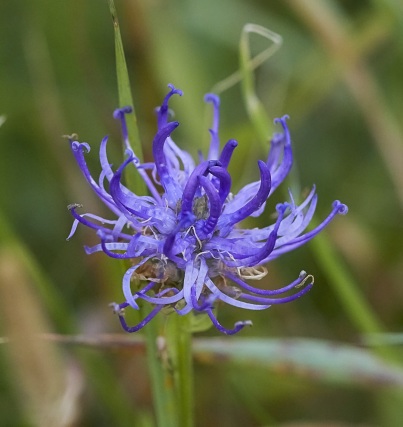
There was plenty of
badger activity to be seen and Helen and Stephanie
were especially lucky to see a hare bound away which
eluded most of us as we scoured the vegetation for the
butterflies. We sat below the trig point of the fort
when a Red Kite decided to inspect us for the
second time and gave great views to finish off the
morning break. White Bryony in flower. Another
memorable morning.

SATURDAY
AUGUST 11 - 2018 - The Trundle
Heather Mills
reported on this morning's walk.
A group of 8 met on a clear and sunny morning to
sample the delights of a new venue for our group. The
Isle of Wight was very visible and we took in the many
sights that stood out, namely Bognor, Chichester,
Portsdown Hill and beyond Calshot chimney.
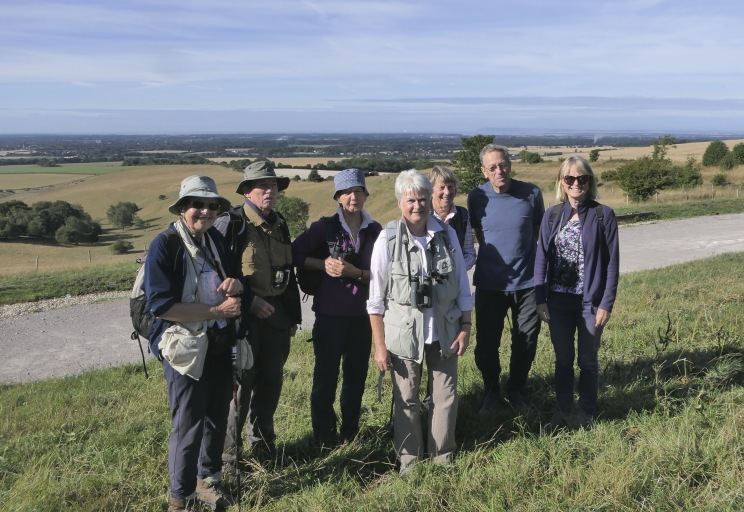
As soon as we began to
gather, a Yellowhammer made it's presence known from
nearby trees.

There were hundreds of
Crows, Rooks and Jackdaws down below us to the south,
taking advantage of the softened earth after the rain
yesterday. The highlight of the morning was a Male Hen
Harrier. It floated over the grassland and dived down
after some prey. Although some were rewarded with a
distant view shortly afterwards, it did not re-appear.
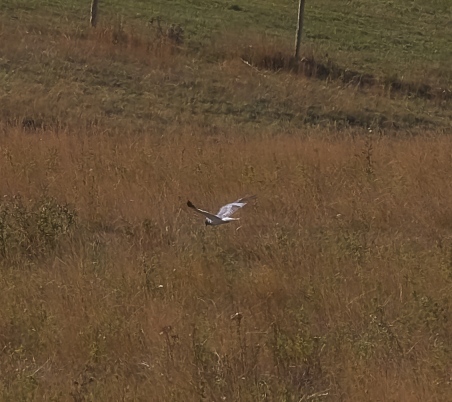
Instead we took
pleasure in the many wild plants hereabouts. Black
Knapweeds, Toadflax, Basil, Dwarf, Carline and Spear
thistles. Burnet Saxifrage Bladder Campion Tufted
vetch, Yarrow and Squinancywort with many Field
Scabious and Round-headed Rampion, Lady's and Hedge
bedstraw, Agrimony and Autumn Hawkbit and Upright
Hedge Parsley identified by Ros. A delightful
selection to name but a few.
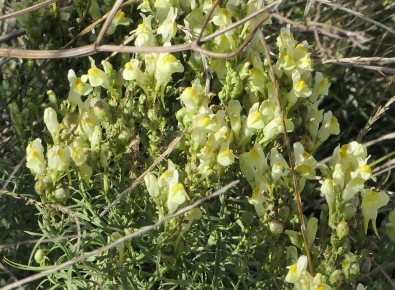
Near the trig point we
were rewarded with a close view of the Yellowhammer
and 2 possible Willow Warblers feeding along the
surrounding bushes.
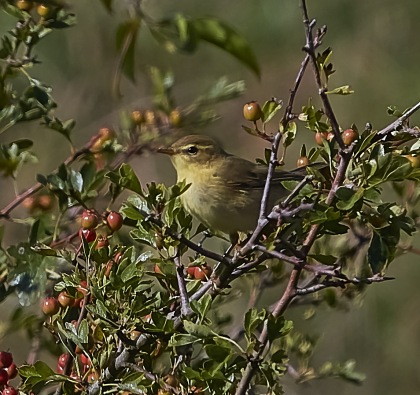
Swallows continually
flew directly over the grassland and very close by
hawking for insects. A vole of sorts scuttled across
the footpath spotted by Val. One that the Kestrel
missed as he hunted nearby. After a welcome break of
watching the Small White and plentiful Common Blues,
Small Heaths and Meadow Browns a surprise Chalk-hill
blue appeared later in the walk. We only managed one
Gatekeeper. Silver Y were mentioned and possible Brown
Argus. .

After a very pleasant
stroll taking in the surrounding hillsides we surveyed
the adjoining bank leading away to the south as
suggested by Diana. A few more Common Blues fluttered
through the grasses and we were thrilled to find a
fresh Argiope Bruennichi, AKA Wasp spider, with 2
grasshoppers in the web.

A large fly alighted
on the Knapweeds and I can only assume that it was a
Cluster fly, a big hairy type.
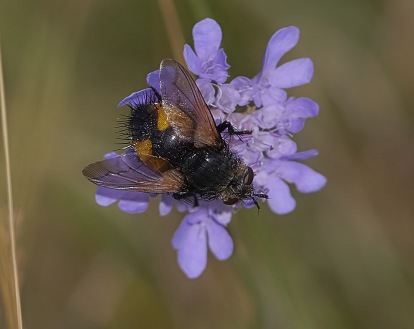
A great morning to
enjoy the simplicity of our wonderful
countryside.
SATURDAY
August 4 - 2018 - Forestside
Steph Dale
reported on Saturday walk by the Havant Wildlife
Group
We had a good turnout of 11 for our walk from
Forestside on Saturday, a particularly hot day.
We saw a lot of butterflies including comma, common
blue, silver washed fritillary, meadow brown, small
copper, speckled wood, painted lady and small copper.
In the woods on Watergate Hanger we saw many speckled
woods swirling around in the dappled light.
Also on a purple
buddleia bush before the woods we saw many dozens of
large and small whites fluttering about. It was a
beautiful sight in the sunshine.
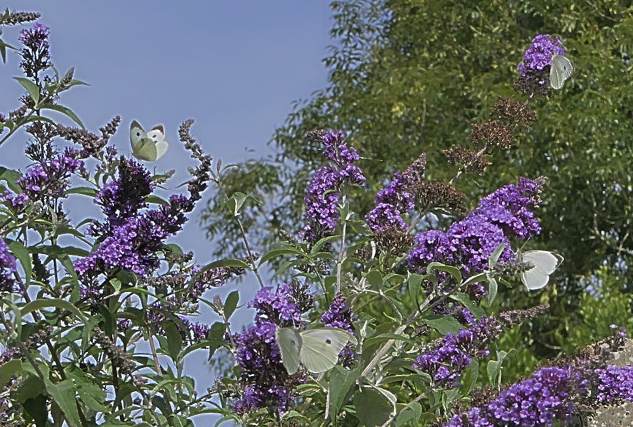
We noticed
hornets emerging from a hole in the barge board
of a farm outbuilding where they presumably had a
nest.
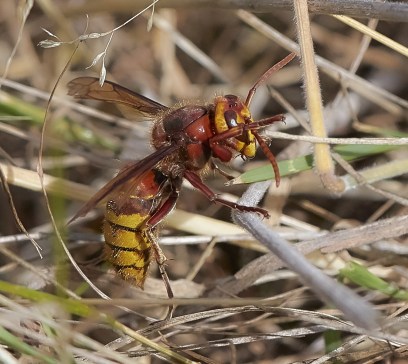
We didn't see all that
many birds but wagtails, a buzzard, a kestrel, house
sparrows, swallows, goldfinches, wrens and
greenfinches were noted. We also heard a chiff chaff,
robins and a young buzzard calling for
food.
Flowers seen were
field bindweed, ragwort, red bartsia, nipplewort,
pineapple mayweed, enchanter's nightshade, scentless
mayweed, black knapweed, scabious, hedge bedstraw,
travellers joy, fleabane, redshank, creeping thistle,
agrimony, yarrow, field speedwell and broad-leaved
willowherb. We noted spurge laurel in the woods (not
in flower) and guelder rose with berries.
Towards the end of the
walk, we stopped at a farm where we were expected and
made welcome for our coffee break which was much
overdue. Thank you all for being patient. We enjoyed
sitting in the shade in the lovely garden watching the
swallows over the farmyard. We visited the two farm
ponds and saw water lilies, an Southern Hawker dragon
fly, a frog and a grasshopper.
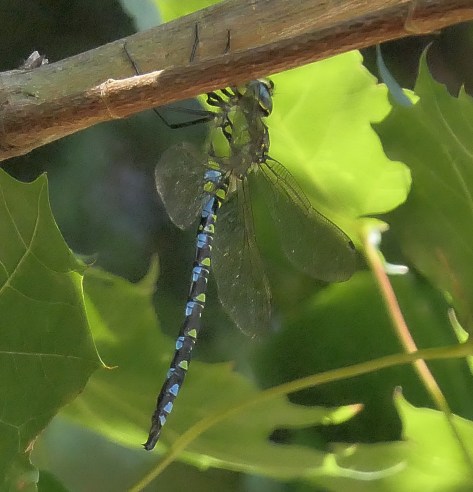
Thanks to all for your
company and expertise.
SATURDAY
JULY 28 - 2018 - Testwood Lakes
Heather Mills
reported this morning's walk
7 met this morning on a slightly changed aspect of
summer. A stiff welcome breeze with clouds racing over
us. Although a Greenfinch "wheezed" in the car park
and a few Goldfinch chattered, the birds were not in
high numbers. A few caught a glimpse of a Whitethroat
in the plentiful blackberries and a possible reed
warbler but other species were quiet. Gatekeepers and
Meadow Browns fluttered along the pathway to the
centre where we discussed the lack of dragonflies in
the shrinking pond. Exuviae of two large dragonfly
could be seen but flying specimens were absent
until we reached another woodland pool. One whirligig
and diving beetle noticed. At the edge of woodland
with a small pool, we came across a hawking Emperor
dragonfly who kept us engaged with it's activity of
checking for possible prey. Moving on through the
woods we noticed the plentiful Hazelnuts which were
turning brown. When we reached the first lake some
were quick enough to catch 2 Wood Sandpipers
before they shot off, leaving Egyptian geese and
Gadwall with a few immature Lapwings dotted around.
The highlight was the
Sand Martin nesting wall with birds constantly
flying in and out. Derek managed a picture that
clearly shows a brood of 3. We did think later on that
they could have been a second brood.
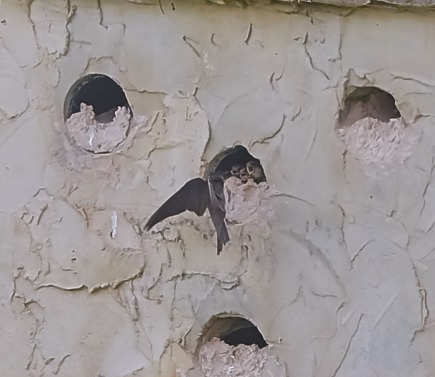
A Grey Heron kept us
very amused with a few circular pirouettes. Very soon
the rain poured down whilst we sat in the hide for a
break and we laughingly supposed the Heron to have
performed a rain dance. In the next hide there were at
least 3 Sandpipers. 2 possible Green and a Common. A
Greenshank was also present with a Great Crested Grebe
and juvenile with head stripes. A Common Tern fished
on the far side and returned to a raft at times. A
Cormorant hung it's wings out to dry and was
accompanied by plentiful Mallards, Coots and Moorhens.
2 Little Egrets also fished along the waters' edge.
Retracing our steps we watched the Sand and House
Martins flying low over the field gathering up
insects. One lone Swallow repeated this in a later
field but they were very noticeably absent hereabouts.
Ros pointed out the Greater Birdsfoot trefoil
and Flowering Rush and we studied the
Yellow Loosestrife alongside the pathway.
A surprise as we left
the second hide came in the grand species of "Chicken
in the wood", noticed by Tony. A pleasant morning had
by all.
Ralph
Hollins closes blog
Founder of the
group Ralph Hollins closed his blog this week.
See tributes at . . . http://familyfellows.com/hwg-ralph.htm
SATURDAY
JULY 21 - 2018 - Iping Common
Heather Mills
reported on this morning's walk by the Havant Wildlife
Group.
8 and 2 halves met
this morning and enjoyed the peace and quiet of a
prime piece of heathland with a warm welcome to
Diana.
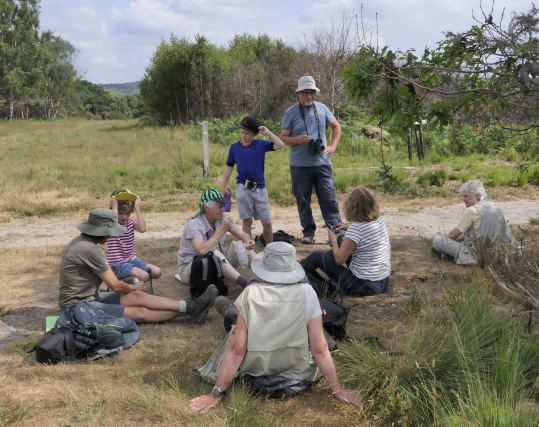
A female Blackcap fed
on the blackberries and gave excellent views. We were
about to cross the Elsted road adjoining the eastern
part of the common to identify and familiarize
ourselves with the 3 Heathers' that are present on
this site. Bell, Calluna vulgaris, and Cross-leaved
Heath. However before we did so we were well and truly
delayed by wonderful Silver-washed fritillaries
which settled right in front of the group on the
Bracken, with a few Gatekeepers.
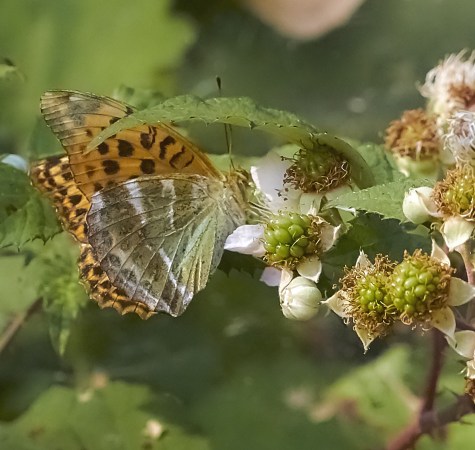
When we could tear
ourselves away from the spectacle to go over the road,
we were also met with a huge Dragonfly, probably a
Southern Hawker giving close views. It was good to
hear several Yellowhammers with one coming very close
for a few to see. Continuing on our usual route across
the Common, we were quickly rewarded with our target
species of Silver Studded Blue spotted by Tony. Not
many about but at least we were able to see them.
Other butterflies seen Green veined white, large
Skipper, Ringlet, Meadow brown, Gatekeeper, large
White, Speckled woods.
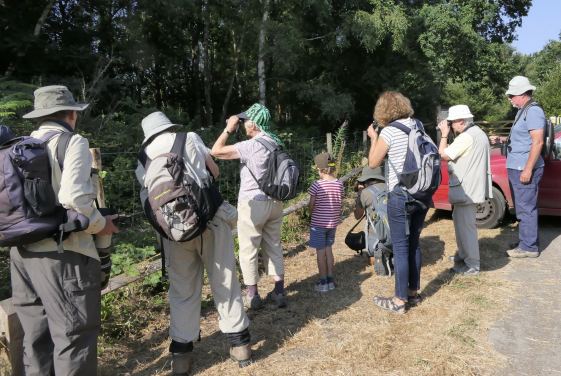
Although the birds
were few and far between later on some were rewarded
with the sighting of a Spotted Flycatcher. Families of
Stonechat also followed each other across the tops of
the bracken and whilst we were disappointed with a
previous boggy area which had dried up, we were
rewarded with a quick flight of Great Spotted
Woodpecker and a Marsh Tit. Having taken a wrong path
we did spot a new growth of " Chicken in the Woods". A
few of the group also saw a lizard dash across the
path. Not identified. We also pondered over a possible
Dartford warbler. The bird appeared to have a
long tail and was quite dark to look at. The jury is
out on this one!
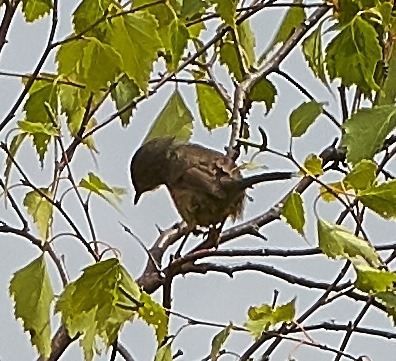
One Dor beetle and a
couple of ladybirds, one being a 7 spot. A pleasant
morning to take in the wildlife at a very slow
pace.

SATURDAY
JULY 14 - 2018 - Langstone
Nicola Hammond
reported on this morning's walk by the Havant Wildlife
Group.
A group of 11 met for a very convivial walk on, once
again, a gloriously sunny morning. Leaving from The
Ship at Langstone, we walked towards South Moor along
the coastal path. A number of whimbrel were seen, well
disguised on the Steve Hooper reline. Oystercatchers
were busy foraging. Large groups of mediterranean and
black headed gulls were also on the shore, plus grey
heron, little egrets and great crested grebe out in
the channel. A curlew was also heard. Looking inland
we saw skylark, linnet, meadow pipit and a kestrel. We
took a coffee break on the sea wall.

and watched a group of
swallows swooping over the field in front of us.
We took an inland path
to continue our journey and were delighted to see
house martins among the swallows. A great spotted
woodpecker was also seen flying over. Plus an
inquisitive Woodpigeon.

Gatekeeper and
speckled wood butterflies were numerous and we also
saw a painted lady, peacock and small skipper.
Thistles were in abundance, including creeping and
spear thistles and beautiful wild teasels. Shoreline
plants included sea purslane, buckthorn, ormwood and
lavender. Other plants seen included wild marjoram,
black knapweed, wild carrot, hogweed, woody
nightshade, ragwort, mallow, tansy, yarrow,
pineappleweed, gipsywort, mayweed and a sloe bush with
early berries.
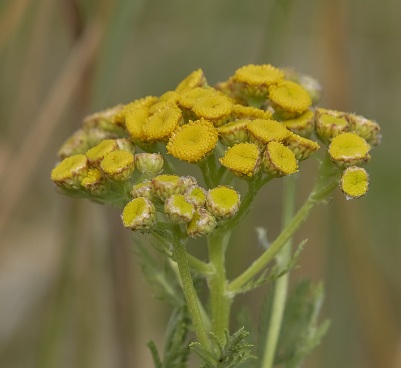
We ended the walk at
Langstone millpond where we saw the numerous little
egrets roosting in the trees.
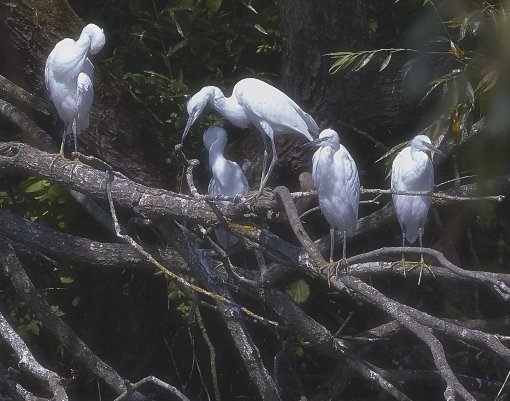
There were 'baby and
teenage' mallard duck families, mute swans, coot,
moorhens and a single female tufted duck. There were
also fine displays of hemlock water dropwort and hemp
agrimony. A very pleasant time was had by
all.
SATURDAY
JULY 7 - 2018 - Portsdown Hill
Ros Norton
reported on this morning's walk by the Havant Wildlife
Group.
A group of seven met
near The Churchillian and walked behind Fort Widley
and further west as far as the roundabout on paths
south of the road on a sunny and very warm morning.
There was an abundance
of busy butterflies which did not help identification
as they rarely posed . An absence of blues was
noticed. Butterflies included many meadow browns,
whites, skippers, a possible silver washed fritillary,
a peacock, gatekeepers and some spotted burnet
moths.
It was lovely to hear
the song of yellowhammers. Other birds seen or heard
included a buzzard, stock doves, whitethroats, chiff
chaff, rook, swallows, swifts, woodpigeons and long
tailed tits.
There was an abundance
of flowers including lesser centaury, hemp agrimony,
nettle leaved bellflowers, field and small scabious,
vipers bugloss, pyramidal orchids, melilot, common
ragwort, rosebay and great willowherbs, creeping
cinquefoil, creeping thistles, greater and black
knapweed, mignonette, red and white clovers, tufted
and kidney vetch, perennial sow thistle, yellow
rattle, mouse ear hawkweed, vervain, bristly
ox-tongue, goats beard, yellow wort, Lucerne, dried
remains of knapweed broomrape, harebell, St Johns
wort, squinancywort, rest harrow, ox-eye daisy, red
bartsia, field bindweed, wild carrot, wildparsnip,
hogweed, ladies and hedge bedstraw.
SATURDAY
JUNE 30 - 2018 - Noar
Hill
Heather Mills
reports on this morning's walk at Noar Hill
Nigel and Rosie kindly made a trip out to Noar Hill to
guide us around this morning to witness the amazing
flora available at this wonderful site. Four of our
group arrived and Nigel brought 2 friends along with
Rosie. A local lady also had contacted Nigel and
joined us. Later we had a small gathering looking at
the Frog orchids. A Kite quickly flew over and
disappeared before the group saw it but we did catch
up with at least 6 Yellowhammers constantly belting
out their song up and down the perimeters.
The Common, Fragrant and Pyramidal orchids were very
much in abundance with a good showing of Musk together
with Tway blades and Frog orchids. Dragon's tooth had
a couple of flowers in the usual pit almost at the
extremity of the pits, but was overshaddowed by the
long grasses. The highlight would have been a Fly
orchid, but sadly even since Nigel did his recci on
Wednesday, it had gone over.
Dragon's Teeth .
. . Frog Orchid . . . Twayblade
Butterflies gave us a
summer spectacle with all the usual specimens at this
time of year except any blues, and I think I had a
first Brown Hairstreak. A Southern Hawker gave good
views when it alighted and stopped hawking along the
footpath in front of some of the group. We did notice
that ticks were very much in evidence when some sat on
the grass for a break!
A very pleasant time
was had by all and thanks to Nigel and
Rosie.
SATURDAY
JUNE 23 - 2018 - Huckswood
Lane
Heather Mills
reported on this morning's walk by the Havant Wildlife
Group
5 met on a gloriously sunny morning and ventured first
to see if we could hear a Turtle dove in the vicinity
over the railway bridge, towards the horse paddocks.
Alas we were unsuccessful.

However, Tony had
spotted a contented pig, serenaded by Guinea fowl,
sunning itself in an adjoining field.
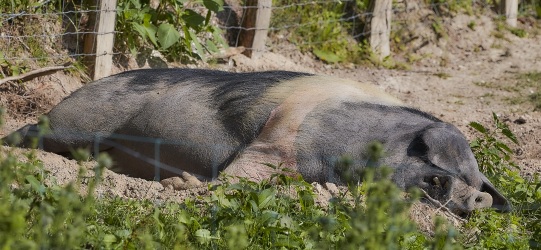
We had a good chorus
of birds singing including a Song Thrush and a
Blackcap male which for once could be seen in a nearby
bush. Further on we had a treat in seeing a couple of
hares out and about. An occasional snatch of
Yellowhammer could be heard but our real enjoyment
came when we walked in view of Uppark to our right and
Ditcham Park on our left with about 15 Skylarks rising
and falling above a crop of broad beans either side of
the footpath. Their glorious song rang out in a clear
blue sky and it looked like the juveniles constantly
chased the parents above the crops.
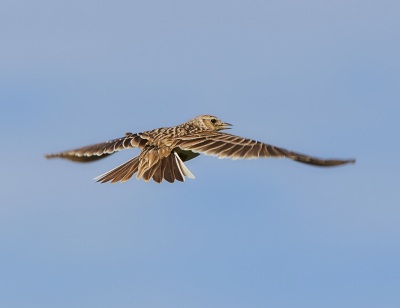
This footpath through
the crop produced some intriguing wild plants. Spotted
by Caroline as being different to the norm were Small
Toadflax, Wall Speedwell identified by Ros, and
Henbit Deadnettle amongst other usual Red,
White and Bladder Campion, Common and Prickly poppy,
and a Musk Thistle with Field Pansy,
Field Madder and Scarlet Pimpernel.
The butterflies were
not in great profusion but we did manage to see
Dark Green fritillary, Ringlets, Brown Argus,
Small Tortoiseshell, Large White, Large Skipper,
Meadow Browns, Speckled Woods, Commas, Red Admirals
and White Admirals with last but not least, a
Gatekeeper.
Silver Y were evident
and a few grasshoppers including I think a Roesel's
Bush cricket. A Mullein moth caterpillar
too.
Caroline's mystery
bug
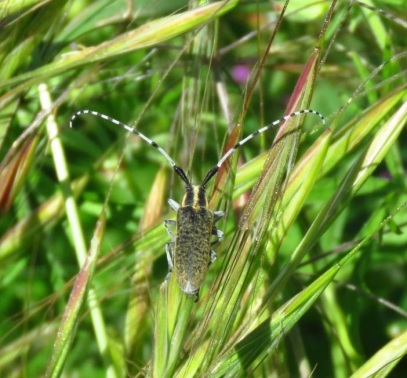
Although some of us
could recall the days when Corn Bunting sang not far
from this farmland it was a morning worth spending in
communion with nature at its best.
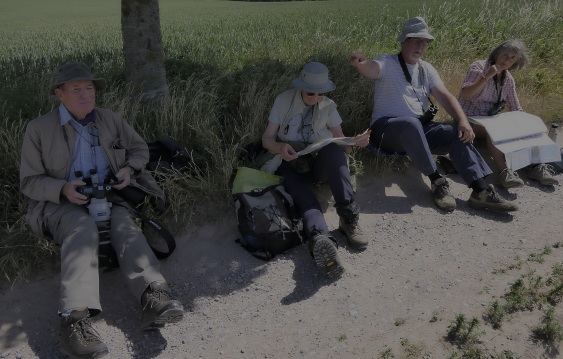
Brian's
notes:
Yes, the grasshopper is a Roesel's Bush-cricket
- fairly common on Brook Meadow.
I tracked down
Caroline's mystery bug as the wonderfully named
Golden-bloomed Grey Longhorn Beetle
(Agapanthia villosoviridescens). Said to
be widespread in grasslands.
A great report and
wonderful photos. Well done!
SATURDAY
JUNE 16 - 2018 Portsdown Hill
Ros Norton
reported today's walk by the Friends of Wildlife
group
A group of nine
met on a cloudy and breezy morning to walk around the
Fort Purbrook area.
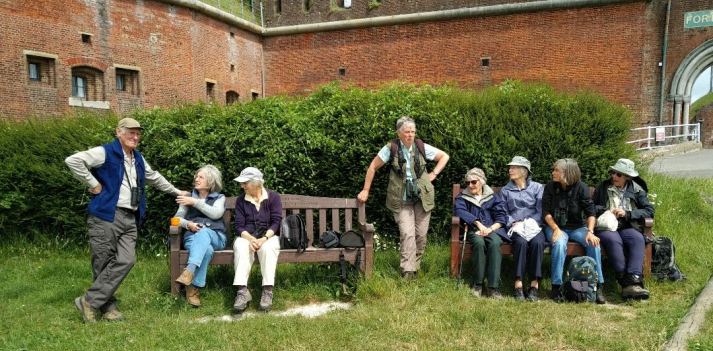
Birds seen or heard
included lesser and common whitethroat, kestrel, rooks
jackdaws, stock dove, collared dove, swifts, wrens,
magpie, goldfinch, greenfinch, blue, great and long
tailed tits.
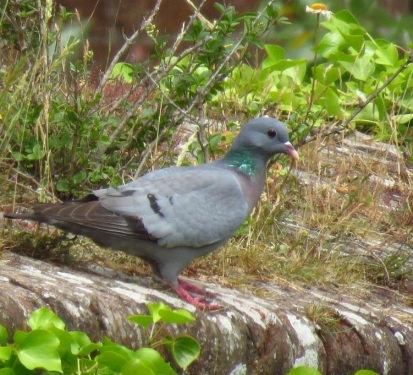
We saw a fox in the
road leading to the fort. We took the lower path below
Fort Purbrook which is getting overgrown in places. It
is a sheltered place for butterflies and today we saw
several marbled whites, ringlet, common blue, meadow
brown and speckled wood.
A crab spider and
various bees were seen.
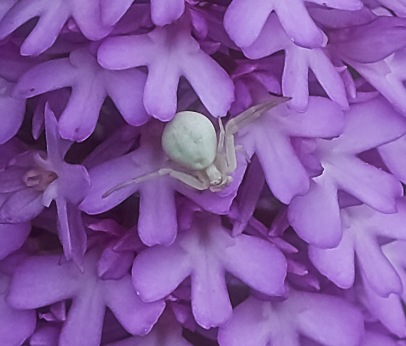
A robins pincushion
was seen in the grass.
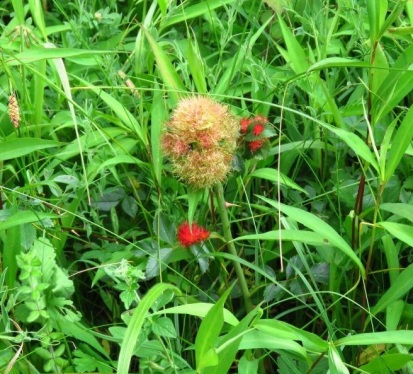
Highlights among an
amazing variety of flowers were the hundreds of
pyramidal orchids, many common spotted orchids and 3
bee orchids. Among the other flowers were knapweed
broomrapes, agrimony, yellow rattle, rosebay
willowherb, rockrose, tufted and kidney vetch, thyme,
flax, fairy flax, catsear, rough hawkbit, mouse ear
hawkweed, nipplewort, beaked hawksbeard, hemlock,
vipers bugloss, milkwort, quaking grass, herb bennet,
St. Johns wort, yellow-wort, red valerian, hedge
woundwort, hedge and ladies bedstraw, field madder,
black and greater knapweed, small scabious, common
storksbill, vervain, self heal, mignonette, meadow
vetchling, birds foot trefoil, ox eye daisy and woody
nightshade. In the field south of the car park we saw
sainfoin.
Photos by Caroline
French and Derek Mills
SATURDAY
June 9 2018 - Hayling Oysterbeds
Ros Norton
reported on the regular morning walk.
A group of two met at Hayling Oysterbeds Car Park for
a walk around West Hayling Nature Reserve including
north Billy line and Oysterbeds. on a warm and calm
morning.
We saw the 2 islands covered in hundreds of noisy
black headed gulls and their fluffy brown chicks and
one oystercatcher among them. There were also two
platforms on the water with nesting common terns but
no chicks seen.
A lesser whitethroat was seen and heard, also a
swallow , cormorant, 2 shelducks , little egrets and a
redshank. Other birds seen or heard included song
thrush, greenfinch, wren, blackbird, chiffchaff,
whitethroat, and blackcap.
Butterflies included painted ladies, common blues,
small whites, a small heath, meadow brown and a
speckled wood.
There were many plants in flower including one plant
of wild clary by the edge of the north end of the
Billy Line path. Really tall groups of hemlock and
groups of ox-eye daisies were eye catching. Other
flowers were hemlock water dropwort, hogweed, wild
carrot and ground elder in the umbellifer family.
Among the other flowers were slender and creeping
thistle, hop trefoil, spotted and black medick, rest
harrow, tufted vetch, hedge woundwort, black
horehound, lesser stitchwort, creeping cinquefoil,
elder, honeysuckle, dog rose, changing forgetmenot,
scarlet pimpernel, cut leaved cranesbill, meadow
buttercup, dogwood, vipers bugloss, sea radish, white,
red and bladder campion, hedge bedstraw, meadowsweet,
woody nightshade, black and greater knapweed, red
valerian , white briony and wild privet.
SATURDAY
June 2 2018 - Hayling Island west
Ros Norton
report on this morning's walk.
A group of 6 met at lay by along Ferry Road for a
circular walk via Gunner Point , Ferry and The Kench
on a lovely warm and sunny day.

We saw so many things
that I will just include the highlights. Many
butterflies seen including a lot of common blues, some
painted ladies, whites, small heaths a small copper
Silver Y moths. Some thigh beetles , damsel and dragon
flies were among the other insects seen. Plus the
first Meadow Brown of the year!
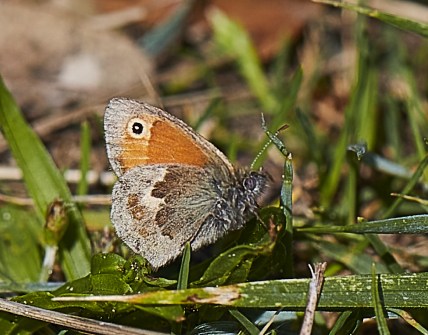
Birds seen or heard
included skylarks, pipits, a male stonechat, linnet,
oystercatcher, ringed plover, heron, little egret,
kestrel, whitethroats, blackcaps, chiffchaffs,
greenfinches, sandwich tern and swallows.
There was a
spectacular display of tree lupins and thrift. Some
little robin plants were seen on the shingle and some
Nottingham catchfly plants in the grass. Hairstail
grass has spread successfully. Other flowers include
sea radish, hoary cress, sea kale, yellow horned
poppy, mouse-ear hawkweed, sea sandwort, sea campion,
hairy tare, hop trefoil, spotted and black medick,
fumitory, green alkanet, sheeps sorrel, sheepsbit
scabious, foxgloves, vipers bugloss, common
storksbill, shining cranesbill, round leaved
cranesbill, dovesfoot cranesbill, cut leaved
cranesbill, yellow rattle, rest harrow and catsear.
A surprise for time of
year was a group of small pale toadstool shaped fungi
in grass.
SATURDAY
MAY 26 - 2018 - Old Winchester Hill
Helen Penfold
reported on this morning's walk.
Eight of us had a lovely walk today at Old Winchester
Hill. Early morning mist gave way to bright sunshine
and the threatened rain stayed away.
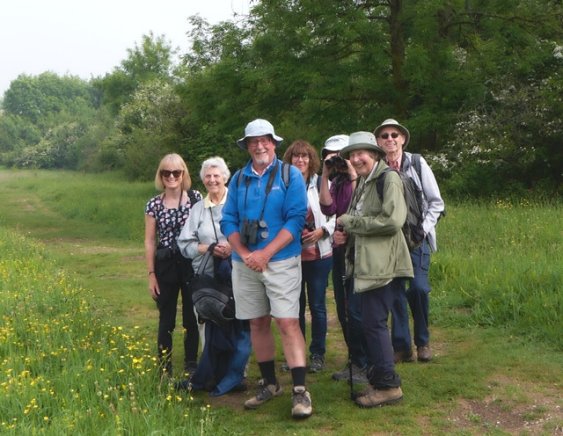
Even before we left
the car park we heard black caps singing, and several
more along the way, but never saw one. Heather heard
willow warblers at the beginning of the grassy walk
and we all heard them on the way back, but again
couldn't see them. We heard and saw several yellow
hammers during the morning, and other birds seen
included kestrels, goldfinches, jackdaws, white
throats, swifts, swallows, house martins, a buzzard
being harassed by a group of crows, chaffinches,
linnets and blue tits.
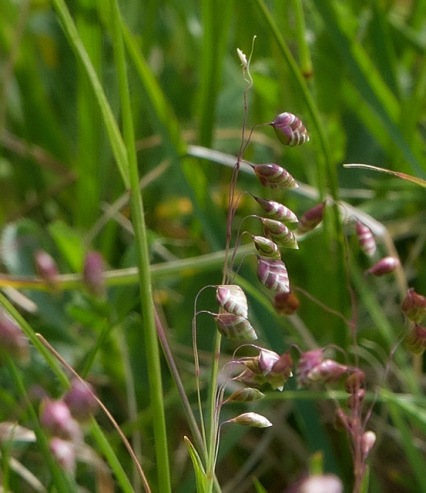
We saw lots of late
spring flowers which included meadow and creeping
buttercups, germander speedwell, blue and pink
milkworts, crosswort, cleavers, horseshoe vetch, birds
foot trefoil, gorse, fairy flax, salad burnet, lesser
stitchwort, red campion, mouse ear, silver weed, wood
avens, ground ivy, quaking grass and fairy ( or
possibly 'purging' )flax.
We saw various
butterflies and insects, including common blues, a
female brimstone, a dingy skipper, a red cardinal
moth, long horned moths and a big brown furry
caterpillar.

Brian's
note: My guess is this long-horned beetle could be
the splendidly named Golden-bloomed Grey Longhorn
Beetle (Agapanthia
villosoviridescens).
SATURDAY
MAY 19 - 2018 - Brook Meadow
Report and
photos by Brian Fellows
I met up with seven members of the Friends of Wildlife
(formerly Havant Wildlife Group) in Bridge Road car
park for their annual visit to Brook Meadow. Numbers
may have been reduced by a clash with the royal
wedding of Harry and Megan!
Before I arrived the group had seen 4 Swifts
flying in the sky, which is the most we have had in
the area so far this year. Let's hope they build up,
but I am not optimistic as numbers have plummeted over
the last 10 years. Heather captured one in this photo.
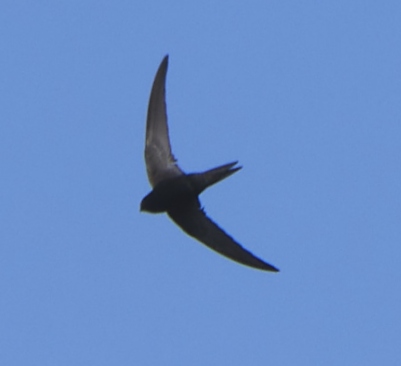
Arriving at Brook
Meadow, we entered through the Seagull Lane gate and
stopped for a moment to look along the recently
cleared path though the dense vegetation to the new
Oak trees which are all doing very well, including the
one that I planted! We stopped for the traditional
group photo before going across the north bridge onto
the main meadow.
From left to
right in the photo are Derek, Dave, Ros, Nicola,
Heather, Fay and Neil.
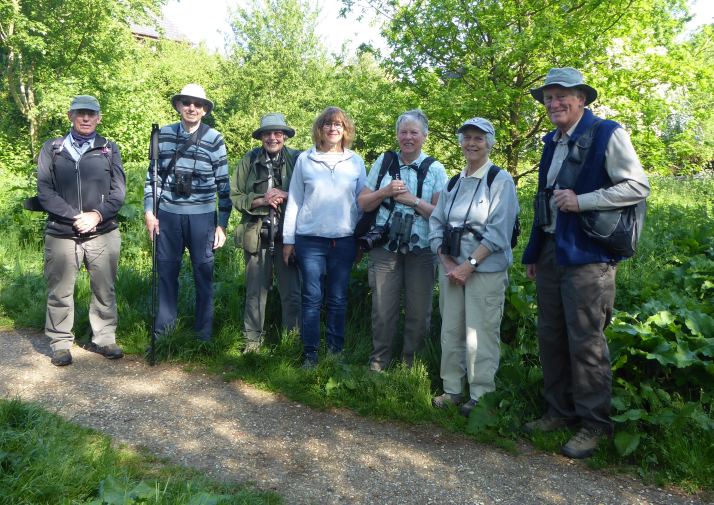
The group was
impressed with the good work done by the conservation
volunteers in clearing the river banks and admired the
avenue of Cow Parsley along the main path.
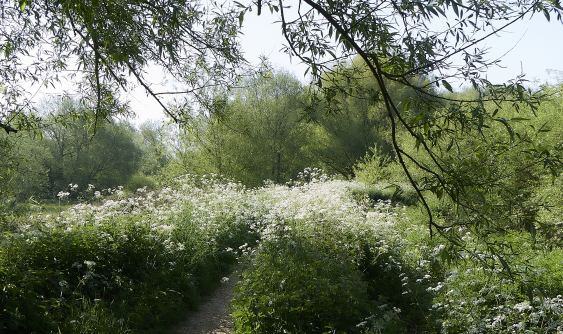
While in the north
meadow we stopped for a while to examine several
grasses, including Meadow Foxtail, Cocksfoot and Tall
Fescue. I was particularly pleased to find the first
Yorkshire Fog of the year and invited Nicola to stroke
its velvety stem.
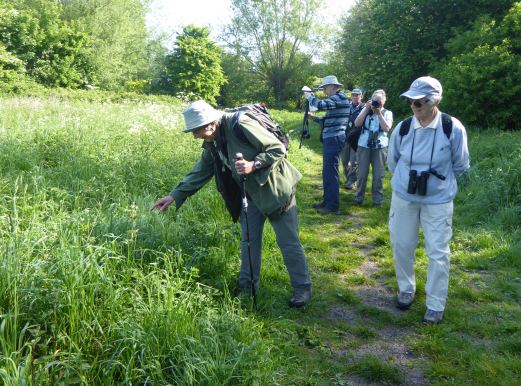
This reminded us all
of Gwynne Johnson's determined efforts get us to
understand and identify grasses. Talking of Gwynne we
stopped briefly by the group of Rowan trees which were
planted in her memory in 2004 and carefully maintained
by the conservation group.
I invited the group
onto the main orchid area which is currently
surrounded by a temporary barrier of branches to
restrict access. This was a good move as Dave
discovered the first of several Southern Marsh
Orchids, just starting to flower and very late
this year. We discovered another couple of Southern
Marsh Orchids on the Lumley area.

The first of the
Southern Marsh Orchids
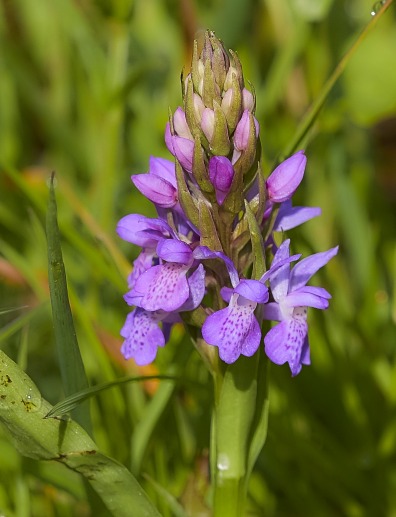

While on the Lumley
area I introduced Nicola to sedges, in particular
comparing Distant Sedge with the similar structured
Hairy Sedge.
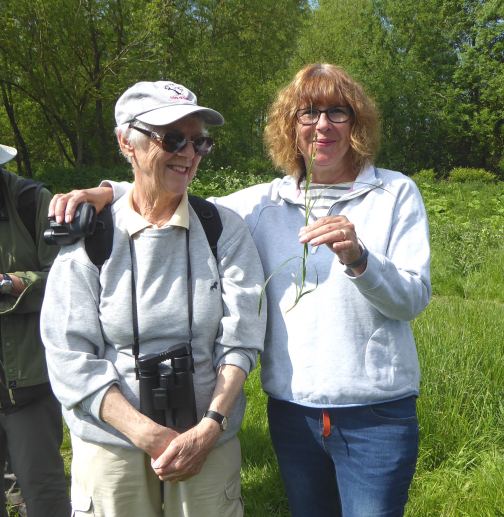
Near the Lumley Stream
we saw several damselflies, including a male Beautiful
Demoiselle an Azure and a pair of Large Reds mating.
We also came across several Froghoppers and a Red
Cardinal Beetle.
Looking for
damselflies
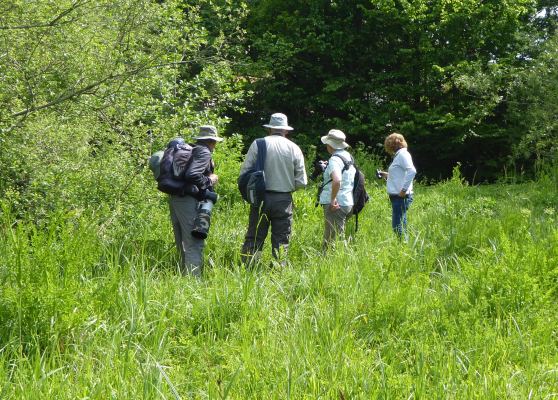
Ros had a look at the
Wintercress flowering on the centre meadow and decided
it was probably B. vulgaris in view of
its large basal leaves.
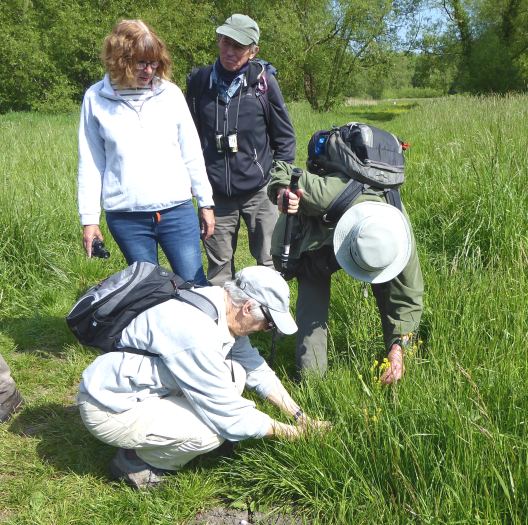
Walking along the
causeway towards the seat for our break we stopped to
admire the attractive pink and white blossom of a
Hawthorn bush.

We stopped for a
coffee break at the main seat overlooking Brook Meadow
where I asked Heather to take a photo of the group
with me in it for a change!

Ros puzzled over some
Forget-me-nots with white and blue flowers and
concluded they were probably Changing Forget-me-not,
but not with complete certainty. Here she is looking
them up in her flower guide.

Best of all for me was
to confirm the presence of at least three male
Whitethroats singing on the meadow for the
first time this year, one from the west side of the
north meadow, one from bushes around the causeway and
another from trees on the edge of the south meadow.
Clearly, they are here at least. Here is a nice shot
of one perched at the top of a tree from Derek.
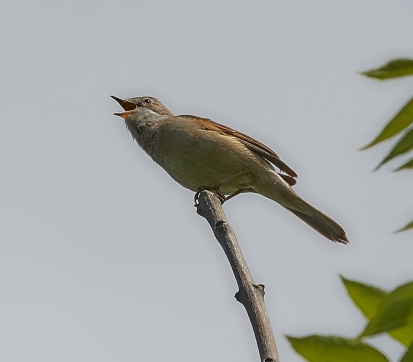
Finally, I took the
group on a trek through the jungle which is the south
meadow hoping for Celery-leaved Buttercup, but not a
sign of anything of interest. So, I bid a fond
farewell to the group at the south gate at about 11am.
In fact, the group did find Celery-leaved Buttercup on
the side of Peter Pond which I recorded on May 17th.
But none on the meadow this year.
PS Thanks to Heather
and Derek for the photos. Some were mine as well.
SATURDAY
May 12, 2018 - Stansted Forest
Heather Mills
reports on this morning's walk. On rather a cold start
to the morning, 7 met to walk around Stansted.
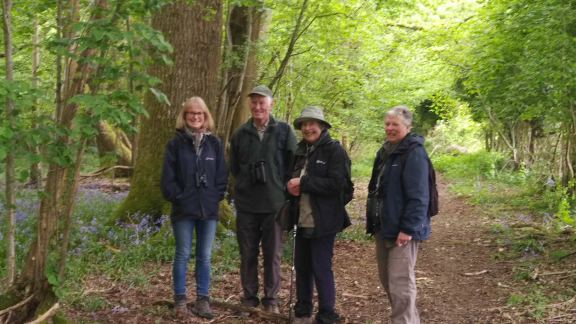
We were rewarded with
a singing Song Thrush and a fleeting visit by 2 Mistle
Thrushes in the car park along with a singing
Blackcap. These were the most prolific songbirds
throughout our walk going in an easterly direction up
towards Lumley Seat. What a busy morning for visitors
to this area. Cars and vans even took to our path at
one point with horses, cyclists, dog walkers and
another walking group. A lone Red Legged Partridge
paced the field with a pair of pheasants.
A very close encounter with a Yellowhammer gave us all
great views. A Whitethroat singing in the hedgerow
never revealed itself even when a group of joggers
passed by. We also had good views of singing Linnets
and at least 4 different sightings of Yellowhammers
who alerted us to their presence with their usual
call, but no song.
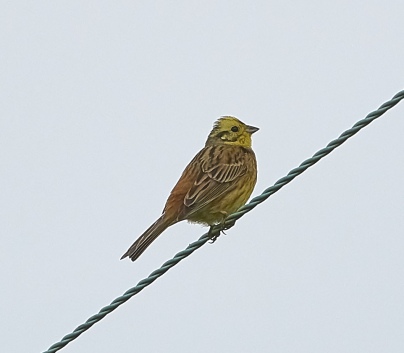
We scanned for hares
but Neil spotted 2 Roe deer instead. We were pleased
to see the array of wild flowers still out and Ros
pointed out Goldilocks buttercup. Red Campion, Greater
Stitchwort, Pignut, Bugle, Yellow Archangel, Cow
parsley with abundant Bluebells.
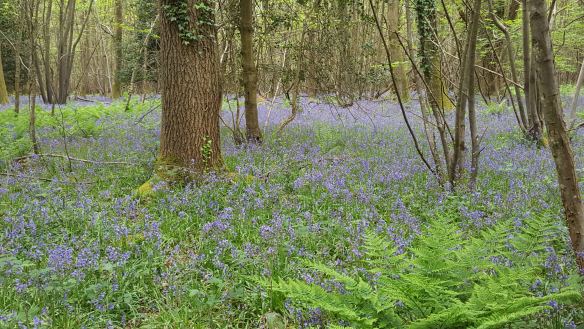
As we turned in at
Broadreed farm Swallows sat on the wire and we heard
House Sparrows and Goldfinches. We enjoyed our
peaceful coffee break at the top of the field and 3
Fallow deer appeared across the ploughed field in
front of us whilst one Skylark sang. Walking back down
Rosamond's Hill, Stephanie showed us a fine display of
early Purple orchids.
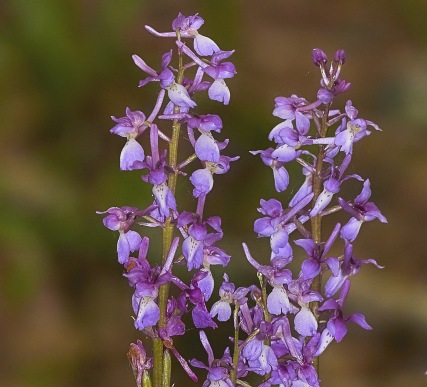
We were thrilled to
hear a Cuckoo on our return and Ros pointed out Yellow
Pimpernel.
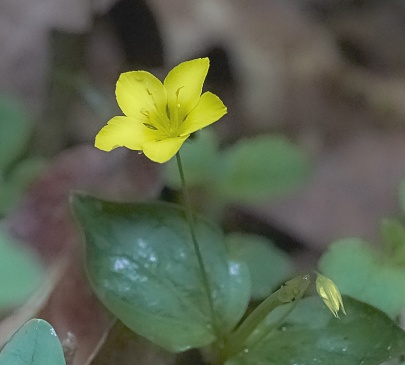
37 species of bird
seen and heard. A very pleasant morning. Jean and Ann
retraced their steps earlier.
SATURDAY
May 5, 2018 - Blashford Lakes
Tony Wootton
reports on this morning's walk
England at it's best, not a cloud in the sky but not
too hot, gentle breeze, every fresh green
imaginable.
11 of us met at Blashford at 9.30 finishing at 3.00.
The leader, i.e. me, had to play mother hen most of
the time trying to keep us all together. At times the
main group was down to 5 as we spread out taking well
earned rests.
Anyway we had a productive day, seeing - Leopards
bane, ground ivy, celandine, herb robert, forgetmenot,
garlic mustard, dandelion, daisy, common mousear,
speedwell, bluebells, wayfarers tree,
hawthorn,bittercress, germander speedwell, bulbous
buttercup, common storksbill, cuckoo flower,
bugle,primose, cowslip.
Brimstone m+f, small tortoiseshell, red admiral,
peacock, common blue, holly blue, small white,
greenveined white, orange tip.
A few of the
group saw a grass snake swimming.
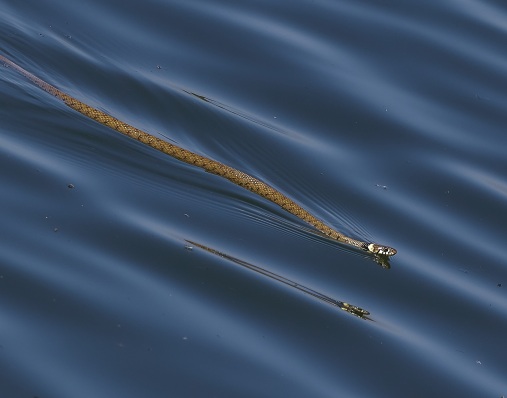
Mute swan, canada
geese, gadwall, mallard, tufted duck, little grebe,
great crested grebe, cormorant, buzzard, moorhen,
coot, oystercatcher lapwing, black headed gull,
herring gull, common tern, feral pigeon, cuckoo (heard
only), sand martin, wren, dunnock, robin, blackbird,
songthrush, sedge warbler, reed warbler, blackcap
(m+f), garden warbler, wood warbler, chiffchaff, blue
tit, great tit, treecreeper, jay, magpie, rook,
chaffinch, greenfinch, goldfinch and a reed bunting.
Surprisingly, I can't recall anyone mentioning swallow
or swift but perhaps I'm wrong.
The moth below is
Oak Beauty
SATURDAY
APRIL 28 - 2018 - West Hayling
Ros Norton
reported on this morning's walk
A select group of 4 met at Ferry Road, Sinah for a
clockwise circuit of West Hayling via beach, Gunner
point and the Kench on an overcast and cold morning.
Two great crested grebes and a possible scoter were in
the sea. On the shingle were ringed plovers and
wheatears while skylarks sang above. At our coffee
stop by ferry some terns including little terns flew
past. At the Kench we saw 17 whimbrel on a mudflat and
a few oystercatchers flew over.
Other birds seen or heard included blackcaps,
whitethroats , greenfinches, jays, swallows, and a
linnet.
Flowers are rather late in appearing this Spring but
highlights included a good number of Green-winged
Orchids, spring beauty, bur chervil, English
scurvygrass, round leaved and doves foot cranesbills,
common storksbill, eastern rocket, green alkanet,
early forgetmenot, garlic mustard and masses of gorse.
Thrift was just coming out and hoary cress still in
bud. Tartar honeysuckle, a garden escape, was
flowering by the car park.
SATURDAY
APRIL 21 - 2018 - North Thorney
Fay Durant
reported on the walk. Nine of us gathered on a
beautifully sunny morning at the junction of Thornham
Lane and Thorney Road . We first viewed the heron
sitting on its nest, plus an egret further over, south
of the lane running westwards, photographed by Nicola.


We then followed a
footpath to the north, which brought us out onto
Prinsted Lane, not far from the coastal path . The
latter we followed as far as the Thorney Island gate ,
where we had coffee overlooking the Great Deep . ( A
diversion was required inland due to the final bridge
being closed ) . We then retraced our steps to
Thornham Lane and back to the cars .
Med gulls were heard
flying overhead , mewing . Neil and later Val
identified male wheatears, very attractive in their
summer plumage . Buzzards and a kestrel were seen in
the sky plus numerous skylarks , in full throttle .
White throats were seen and heard plus chiffchaff ,
linnets , numerous black caps , house sparrows -green
finch and green woodpecker were heard . On the Great
deep were two shell duck , a coot and a good number of
gadwall . A striking male roe deer was spotted sitting
in one of the fields and mining bees were emerging
from the side of the footpath , so small .
Many flowers were seen
, Alexanders were prolific , red and white dead nettle
,common stalks bill, garlic mustard , ivy leaved
speedwell , ground ivy , cow parsley, common chickweed
, meadow buttercup plus hawthorn and blackthorn bushes
in flower .
A few butterflies :
large white , brimstone , red admiral . Appreciated
all the support .
SATURDAY
APRIL 14 - 2018 - Lowtons Copse and Blagden Copse,
Clanfield
Steph Dale
reports on the morning walk.
Despite a very foggy
start to the day, nine of us met in Clanfield for a
walk up Little Hyden Lane to Blagden Copse and then
back via North Lane and Lowtons Copse. Before too long
we were rewarded by warm sunshine - a real treat!
Woolly hats and coats were shed.
There was a lot of birdsong but we could not always
trace the birds doing the singing. We heard, but did
not see, a woodlark, nuthatches, chiffchaffs, a
dunnock and blackcaps. However we did see great tits,
a song thrush, buzzards, a stock dove, robins and a
swallow, not to mention an owl - more of that
later!
We saw lots of beautiful flowers, especially starry
carpets of wood anemones. The bluebells are mostly not
flowering yet but we did see a few out. On the banks
along the paths and road we saw sweet woodruff,
ground-ivy, wood sorrel, moschatel, ivy leaved
speedwell, dog violets, lesser celandines, primroses,
dogs mercury, pulmonaria, yellow archangel, figwort,
wood sorrel and wild strawberry. In the woods we saw
broom, wood spurge, wood anemones and Toothwort. In a
garden on the lane we saw a lovely Pasque
flower.
Moschatel . . . .
. . . . . . . . . . . . . . . . . . . Toothwort
We saw a number of
brimstones darting about and early on in the walk we
came across a badger latrine.
We had coffee in the
sunshine on the edge of an open field facing south.
The highlight of the
walk came towards the end when we saw a tawny
owl near the top of a beech tree behind a house.
The owners of the house drove up while we were in the
drive of their house trying to get a better view of
the owl! Luckily, far from being cross, they kindly
let us into the paddock behind the beech trees so that
we could get closer to the owl. We got a good view of
it and Derek managed to photograph it. Brian's
note: that's a first for the Saturday morning
group!

Lovely sunny walk with
lots to see and thank you all for your
company.
SATURDAY
MARCH 17 - 2018 - Chirchester Marina
Steph Dale
reported:
Despite the forecast for snow, eight of us met at
Chichester Marina for a walk around the marina and
along a stretch of the canal. As we walked around the
marina we saw a buzzard overhead and Tony spotted a
sparrowhawk. Along the shore we saw black-tailed
godwits, shelduck, teal, great crested grebes, little
grebes, redshanks and black-headed gulls. Along the
canal we saw mallard, tufted ducks, coots, moorhens,
swans and green woodpecker. All the other birds were
obviously sheltering from the wind to keep warm.
Flowers seen were celandines, primroses and sweet
violets.
After a quick coffee break on a bench by the canal, we
headed back to the car park just in time to drive home
with snow falling. Thank you for your company,
everyone
SATURDAY
MARCH 10 - 2018 - Langstone
Ros Norton
reports on this morning's walk.
A select group of 3 braved the rain to meet at
Langstone on a showery, warm and calm morning. We
walked east along Mill Lane, past West Mill and turned
south to follow the Langbrook stream to Langstone
Harbour where many birds were gathering along the
entrance to the stream and feeding along the waters
edge along the waters edge by South Moors. The birds
seen included mergansers, wigeon, oystercatchers,
dunlin, gadwall, oystercatchers, turnstone, shelduck,
shovellers, black headed gulls, black backed gull and
Mediterranean gulls.
A skylark and a meadow pipit ascended in song over
South Moors and a rock pipit flitted along the shore.
We made for a bench on Budds Mound for our coffee
break overlooking ponds which had coots, mallards,
tufted ducks, a little grebe, shelducks and
shovellers.
Birds were singing well in the bushes along the walk
including robins, goldcrest, wren, dunnock, great and
blue tits.
Few flowers included cherry plum, red deadnettle,
gorse and dandelion.
SATURDAY
FEBRUARY 24 - 2018 - Southsea
Fay Durant
reported on this morning's walk:
Four brave souls met in Eastern Parade, Southsea, for
our Saturday morning walk . The weather forecast had
said very cold winds to be expected, in fact, it was a
gloriously sunny morning, blue skies and the wind was
quite tolerable, hardly noticed at times .
We walked down to the beach and did a quick
inspection, passing the cricket pitch on the way,
where the Brent Geese were beginning to gather, plus a
group of gulls. ( On our return there were more than a
hundred Brent's , busily feeding ) .
There was little bird - wise on the beach and we
couldn't find any star fish, until Ros found one
later, with one leg missing ! We then progressed
through the rose garden where a wren was heard singing
and a dunnock seen and heard. In the Japanese garden
groups of green finch and gold finch were flitting
around, plus black birds darting about.
Up above the battlements, we noted a large hole, which
might be the residence of the local fox .
Just before walking round Canoe Lake, we strolled into
Cumberland House garden, where we inspected the new
butterfly house - no butterflies expected until around
May time. Exiting we saw a pied wagtail, in the flower
bed. A large gathering of gulls on the green but no
Mediterraneans to be seen. Loads of swans on the lake,
plus model boats !
We then made our way to Southsea Castle where we saw
just two purple sandpipers and two rock pipits.
(Twelve purple sand pipers were noted earlier in the
week) .parrows and starlings were making use of the
soft red bricks in the outer castle walls, for
digestive purposes.
Beryl , Anne and Jean joined our small group for a
very welcome drink at Rocksbys, plus nourishment,
provided, very generously by one of the group, much
appreciated . Neil saw his first chiffchaff of the
year in the rock gardens, unfortunately missed by the
rest of the group . We retraced our steps but nothing
more of interest was noted .
Ros identified red dead nettle and field speedwell
growing along the edge of the cricket field . A very
enjoyable morning , in spite of the forecast - Sunny
Southsea lived up to its name ! Thanks must go to
those who braved the elements .Regards , Fay
.
SATURDAY
FEBRUARY 17 - 2018 - Hayling Oysterbeds
Ros Norton
reported on this morning's walk
A group of 8 met at
Oysterbeds car park on a lovely calm sunny morning for
an anticlockwise walk around the oysterbeds. We first
looked around the low tide mud by the car park and saw
brent, godwits, turnstones, redshank, oystercatchers,
curlew and a little egret. We then walked north along
the Billy Line hearing much birdsong. A great spotted
woodpecker drummed and a green woodpecker yaffled. A
buzzard and a kestrel perched in trees. Other birds
seen or heard included greenfinches, goldfinches,
blackbirds, robin, great tit, long tailed tit, stock
dove, pied wagtail and starlings.

At the flooded field a
pair of mallards , an egret, redshank and colour
ringed greenshank (black/red left and double
yellow right leg) were seen.
We had coffee break at
the signal path junction where Chris joined us. A
buzzard flew overhead and in the distance in the
harbour 43 mergansers, 9 little grebes, several great
crested grebes, black necked grebes, goldeneye ducks
and a long tailed duck were seen thanks to our
telescopes and Heather spotting hem.
We returned via the
Oysterbeds where a high tide roost including many
oystercatchers and dunlin was gathering. The dunlin
flew in cloud formation and we saw more brent,
pintail, wigeon, redshanks, curlew and gadwall.

There was a distant
great northern diver and a seal seen. On the oysterbed
islands among large numbers of black headed gulls were
some Mediterranean gulls also a cormorant and crows.
Some mergansers and little grebes were within the
oysterbeds.

Flowers included sweet
violets, snowdrops, gorse and winter
heliotrope.
SATURDAY
FEBRUARY 10 - 2018 - Milton Shore
Heather Mills
reported on this morning's walk.
8 met on a decidedly cold and grey morning with ice
still in the puddles. Our first sighting being a flock
of about a dozen House Sparrows in the brambles with a
small flock of Starlings circling overhead and one
Song Thrush singing. 7 Moorhen poked over the grass.
We set off quite briskly alongside the playing fields
towards the small Milton reserve on the southern
shore. A Great tit belted out his song as we
approached Locksway road. Ros found one Sweet Violet.

The falling tide gave
good views of a shoreline peppered with Brent geese
and Redshanks with a few Oystercatchers and one female
Curlew . As we continued towards the sailing club
looking towards Hayling ferry, a small flock of Dunlin
appeared with a few Ringed Plover which were good to
see close up. Turnstones were also much in evidence
tossing the sea-weed aside.
As we crossed the old
lock entrance a Rock Pipit gave us a good indication
of it's habitat as it searched for food.

Brian's
Note: Derek's photo looks like a Meadow Pipit with its
overall brown plumage. Rock Pipit would have a much
greyer plumage. Meadow Pipits do forage on the shore
with Rock Pipits in winter.
Moving on I heard the
distinct call "kee-errk" of a Sandwich Tern. It came
towards the shore briefly before returning over to the
Hayling side. Neil spotted a Great Crested Grebe.
Dunnocks repeatedly sang along with
Greenfinch.

We had one snatch of a
Cetti's warbler, repeated more distinctly later. A
Buzzard sat close by a pestering Magpie. The usual
inhabitants of the lakes were seen, Mallards, Tufted
ducks. Fay spotted a fine male Shoveler and later a
pair of Gadwall. Coot, with a pair of Mute Swans on
the lake and one pair on the shoreline swam with half
a dozen whistling Teal .
The seating came in welcome to have our coffee break
at the services monument, serenaded by a Robin and
surrounded by many feral pigeons and the resident
Doves with a flock of Goldfinch to keep us company. 41
birds seen and one Green Woodpecker yaffle heard .
Also a handsome Brown rat munched on the vegetation in
full view. Other plants seen a speedwell, Dead-nettle
and Ragwort in flower.

SATURDAY
FEBRUARY 3 - 2018 - Warsash
Valerie
Mitchell reported on this morning's walk
Eight enthusiasts met at the car park in Warsash for a
walk along the River Hamble, although it was
drizzling, there was little wind and temperature was
above freezing. As the tide was low there was plenty
of waders and they were all within good viewing
distances on both sides of the Causeway.
We saw plenty of redshank, wigeon, teal, shelduck,
black tailed godwits, curlews, turnstones, dunlin,
brent geese, and wood pigeons in the tree tops. A
couple of rock pipits flew ahead of us, little grebes,
great crested grebes were busy diving, Black headed
gulls, herring gulls, little egrets and
cormorants,oyster catchers and lapwings were easily
seen. And a Greenshank.

A buzzard sat in the
tree watching us, a great spotted woodpecker was heard
continually drumming in the background, a song thrush
was spotted, having heard its song, having seen a few
grey plovers, the star of the show was group of about
12 golden plovers just sitting at the water's edge.

A pair of pied
wagtails bobbed around while we had our coffee at
universal Marina. Plants seen were Alexanders and
celandine.
We look forward to planning another visit to here
later in the season,
SATURDAY
JANUARY 27 - 2018 - Walderton - Stansted
Steph Dale
reported on this morning's walk
Seven of us met at Walderton this morning. In order to
avoid the worst of the mud we walked up Brocks Knapp
Hill, along Woodlands Lane to Irongate Cottages in
Stansted, coming back via Lumley Seat. The weather
started out quite good but by about half way was
beginning to become drizzly.
Very near the car parking area we found a tiny nest on
the ground, presumably blown from a tree. In the
nearby horse pasture we saw a parliament of rooks with
three jackdaws nearby. We heard quite a few birdcalls
during the walk but did not always see the birds
making the calls. We did see goldfinches, a wren,
robins, great tits, starlings, a song thrush and
pheasants. In a field at the back of Lumley Seat, we
saw starlings and fieldfares. We saw a buzzard flying
high and later Dave spotted one perched in a tree
quite close to us. We heard a mistle thrush, coal tits
and a marsh tit.
Flowers seen were gorse, stinking hellebore,
hogweed and even pink campion. We also saw King
Alfred's Buns fungus.

The highlight of the
walk was seeing a very obliging hare which kept still
for quite some while as we watched it.

SATURDAY
JANUARY 20 - 2018 -
Emsworth
The Friends of
Wildlife met in Bridge Road car park this morning for
their walk in Emsworth. I was sorry I could not join
them, but despite the wet weather they had a great
time and Emsworth certainly lived up to its rightful
reputation as one of the best birdwatching spots in
the country! Here is Fay Durant's report along with a
few photos of the highlights.
Eight brave souls met on a very grey, misty, damp
morning at Bridge Road car park. ( The venue had to be
changed due to the state of the terrain.) I had no
great expectations of the morning but it turned out to
be quite exceptional . We started off along the west
shore of the mill pond, noting how much cleaner it
looked. There was the usual collection of mallards ,
coots and swans then Ros saw the flash of a
Kingfisher and it landed on a low branch of a
bush, hanging down in front of the pond wall and there
it stayed for all to admire! Photo by Steph Dale.

When we reached the
sailing club we turned west towards Nore Barn. The
tide was well out but a large group of dunlin were
noted, also wigeon, shelduck, pintails, oystercatchers
and a few grey plovers. Plenty of Brent geese, of
course. Later very good close ups of oystercatchers
and wigeon.

We approached the
famous stream where the spotted redshank was
slowly making its way to where we were. It seemed to
have no fear of us and came really close, walking
across the pebbles, providing an excellent opportunity
for good photographs.

We proceeded further
along the shore and saw four black tailed godwits,
curlew, redshank, teal and on our return a great
crested grebe. As we turned inland, at the edge of the
wood, quick sighted Heather saw two birds flash by: a
goldcrest and a firecrest , the latter seldom seen.
Glimpses of these birds were seen again, further on,
and the firecrest actually flew up from our feet. We
stood by the gate leading to Warblington church and,
whilst looking for grey wagtail, a nuthatch was noted
on the thick branch of a tree, beside the stream. It
was busy throwing moss off the branch, looking for
insects. It remained for a long time.

We walked a little way
up the path opposite and heard song thrush etc but no
sign of bullfinches. Walking back, eastwards, Heather
saw some greenfinches. We had seen numerous sparrows,
dunnocks, robins and blackbirds during the walk plus
blue tits, great tits, long tails, goldfinch, crows
and a wren. Later a sparrowhawk was seen diving in to
the woodland. We had a nice coffee break sitting by
the waters edge, with ducks etc in the background .
Photo by Sue of some of us gathering for coffee at
Nore Barn, left to right Stephanie, Heather, Fay and
Helen.

When we returned to
the mill pond we saw the elusive goosander and
another good siting of the kingfisher - twice in one
day!

Plus a dab chick. In
the wood we had seen a very nice bush of butchers
broom with red berries and one flower noted. Photo
by Heather from her phone.

Also in the lane a
good number of common horsetail. Celandine were
starting to flower. My, what a morning and the moral
being, never let the weather put you off! Thanks to
all those who made the effort to turn out .
SATURDAY
JANUARY 13 - 2018 - Cams Hall
Heather Mills
reported on this morning's walk.
This morning on a decidedly cold and grey morning 12
met to explore the waters of Fareham creek around Cams
Hall. Whilst we were waiting to set off, a flock of 8
Curlew flew towards us and a couple could be heard
calling. We were eagerly welcomed by a couple of
officials guiding apparently 200 joggers out and about
on the same route. We were not dismayed and set off to
walk along the creek. As it was high tide we did not
expect our usual waders but were pleased to see 35
mute swans early on and one little Egret. We were not
able to see the usual view of a Kingfisher early on in
the walk, but some did catch up with brief views of it
hovering over the sea at some distance on the far side
of the creek. Brent Geese very much in evidence with
Black-tailed Godwits and a few flocks of Redshank. A
couple of Collared Doves sat on the shore. Although at
first we only saw about 6 Wigeon, later on a whole
raft could be seen on the tide along the eastern end
of the creek. Many of the Oystercatchers rested on the
pontoons. One of the many Cormorant about in the creek
took off and gave us good views of it's breeding
condition with his white head and white underarm
breeding patches.
One Greenfinch was heard first and seen flying. Later
a possible Bullfinch along with views of Goldcrest and
Long-tailed Tits, together with Blue tits. Four Little
Grebes could be seen in the middle of the creek avidly
diving, but later a few more were seen. Good views
were had of Red Breasted Mergansers, a male with 2
females close inshore and Great Crested Grebes.

A female Kestrel
hovered nearby and Crows pestered 2 Buzzards. Plenty
of Black-headed Gulls but we did not spot any with
Black Heads. As we neared the end of our walk we heard
Great Spots and sure enough 2 appeared. A Song Thrush
sang from the bushes but could not be located.
Starlings dotted the power lines and one male House
Sparrow flitted through.
A good morning but rather lacking in our usual number
of birds as only 39 seen and heard.
SATURDAY JANUARY 6 - 2018 - Nutbourne
Helen Penfold
reported on this morning's walk
Nine of us had an enjoyable walk at Nutbourne, this
morning, despite it being a damp, overcast day with a
cold wind.
On the way to the shore we saw a heron take off across
the field to our right, and soon after getting to the
shore, Neil identified a group of avocets, some way
out in the water. We were able to see them more
clearly from the point. And when we came back later,
after coffee at Prinsted, when the sun had appeared to
make everything more beautiful, there was a group of
60 or more avocets, nestling around the point,
with wonderful views through Neil's telescope. They
were alarmed by a group of young people on the beach,
and took flight towards Hayling, giving us a great
view of them in the sunlight. Photo from Tony Wootton.

Other highlights of
the day included a flock of 25 or more curlews which
we watched feeding in one of the fields, until they
took off and flew over us. Later we saw them all
pecking amongst the sea weed, very well camouflaged,
so that at one moment we couldn't see any, and then,
once we had found one, we could see lots, until they
flew off again in a big sweep. Many dunlin were
running about at the water's edge, with a solitary
grey plover among them. Turnstones, oyster catchers,
redshank, a few little egrets and a ringed plover were
pottering about over the sea weed, and we saw teal,
wigeon, pintail, shelduck many brent geese, and a
great crested grebe on the water.
Walking back from Prinsted, we saw a male stonechat
flitting from post to post, and a bit further along
there were two deer, hardly visible as they stood in
front of the hedge. There were five or six thrushes in
the next field, which Tony and Neil thought were a
mixture of song thrushes and one or two mistle
thrushes. We had previously seen a solitary
fieldfare.
We also saw robins, magpies, goldfinches, a flock of
linnets, swans, starlings and crows.
FOR
2017 WALKS REPORTS GO TO .
.
. 2017